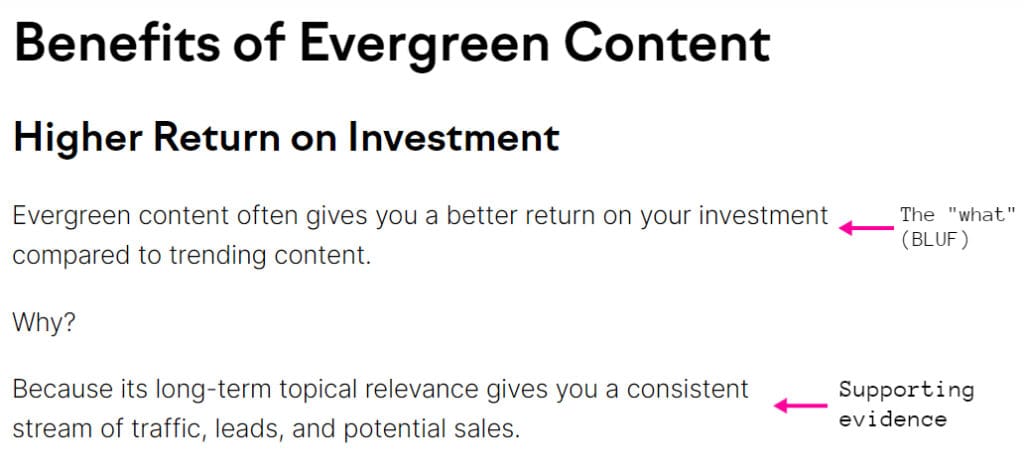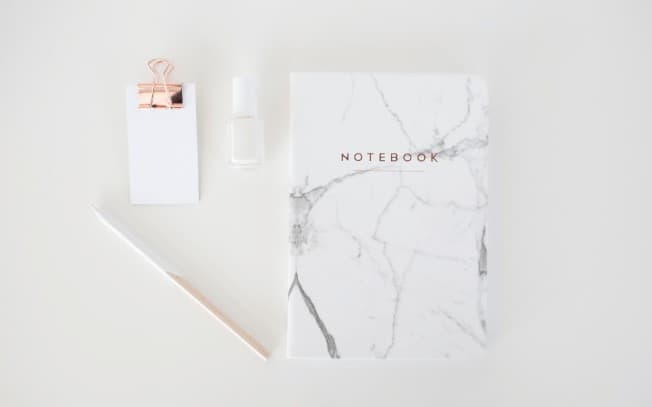Last Updated on
BLUF is a powerful way to improve your writing.
Whether you’re writing blog posts or emails, applying the BLUF technique will ensure your readers stick around and read your entire message.
What is Bottom Line Up From (BLUF)?
The BLUF acronym stands for Bottom Line Up Front. It’s when you give readers the main message or key takeaway at the beginning of your writing instead of burying it deep down.
It’s similar to the inverted pyramid method many journalists use when writing news articles.
The main difference?
With BLUF, you state the key takeaway first before diving into things like examples or supporting evidence.
With the inverted pyramid, you start with the most important facts and following with less important information in descending order.
Here’s an example of BLUF in the context of an email.
| Non-BLUF | BLUF |
| Hi Dana, I hope you’re doing well. I was wondering what you’re schedule is like this week? Are you free for a 15-minute video call? We’d love to discuss some new features from our software, and would like to hear your thoughts. | Hi Dana, Are you free this week for a 15-minute video call to discuss some new software features? We’d love to hear your opinion. Hope you’re doing well. |
The BLUF email gets straight to the main point. Whereas the other one has some preamble before diving in.
BLUF is an effective writing technique as it gives the answer the reader wants right away.
And using it can help you improve your writing.
Where Does BLUF come from?
BLUF is a military technique, originally created to convey messages quickly, concisely, and effectively.
5 reasons BLUF is so effective
1. BLUF places the user at the heart of your content
BLUF is user-friendly. With the key takeaway front and center, readers don’t need to dig through blog posts or emails to get to your main point.
2. BLUF makes content easier to digest
By front-loading the most important information, you increase the chance that your message is read, understood, and remembered.
According to HubSpot, only 27% of people read blog posts thoroughly, with 73% only skimming.
The traffic you receive to your articles is precious. And you want more than 27% of people to remember your message.
3. BLUF can increase conversions
More people will convert when they get the gist of your message.
If people have to dig through your content to find the answers they want, they’ll feel frustrated, give up, and leave without converting.
But when they quickly find their answer, they’ll have an overall better user experience.
And better user experiences often result in more conversions.
Whether you want leads or sales, you can nudge people in the right direction by applying BLUF techniques to your content.
4. BLUF helps you organize your ideas
When you drill down to the core concept of each section you write, you can get a good feel for which sections are useful and which to omit.
Think of BLUF as a mini-thesis for each section you write. Now ask yourself, “does this mini-thesis align with the core themes/overall thesis of my piece?”
If the answer is no, rework or omit said section.
5. BLUF is adaptable
BLUF isn’t just for marketing content, like blog posts or emails. You can apply the same principles to presentations or Slack messages between you and coworkers, making it a versatile technique.
Examples of BLUF
Seeing examples of BLUF is the best way to understand how it works.
Here are four examples from my own writing. Three are BLUF, and one is not.
Let’s start with one that uses BLUF:

The above example is from a blog article on ‘evergreen content.’ In this example, the first sentence explicitly states that evergreen content often gives a better ROI.
The subsequent sentences then build up support for the initial claim.
This way, as someone scrolls through the piece, they can read the first sentence on every section and get the gist of what it’s about.
Let’s look at another section that uses BLUF. This article compares Shopify with WordPress. In this specific section, we’re discussing storefront design.

Again, the first sentence summarizes the core theme of the section.
So far, both of these examples have discussed the “what” (what has a high ROI? Evergreen content. And which [what] platform/who has better storefront design capabilities? Both WordPress and Shopify).
Let’s look at one that starts with a “why.” This article is a website launch checklist. It details everything you should do before launching a website. Take a read:

In this section, I started off with a “why” and answered the question “why should people compress their images?” The answer? Small image files help your site run fast.
Now that you’ve seen some examples of BLUF, let’s look at one that doesn’t follow BLUF’s principles. This example is an article I wrote about lead magnets, and it lists different lead magnet types.

We can make this section BLUF by swapping the second sentence with the first one. That way, we’d define why workbooks are a valuable lead magnet.
How to start using BLUF
As I’ve mentioned before, you write BLUF by including the main point of each section and moving it to the top.
However, I found this tricky to implement when I started incorporating BLUF into my writing.
Oftentimes, I’d think my writing was BLUF, but my editor would leave me comments saying, “make sure you use BLUF for this section.”
But then my editor gave me a handy tip: You can typically write with BLUF in mind by answering the “why” (why is this important?) or the “what” (what is this?).
Let’s go through a couple of examples I created using ChatGPT. We can review them and see which line we’d move up to make it BLUF.
BLUF practice example #1
Here’s our first example:
Keyword Research
Let’s say you sell knitted sweaters.
You probably want to rank for keywords like “knitting sweaters” or “handmade sweaters.”
But what other keywords can you rank for?
Keyword research helps you find keywords your site can rank for, so you can increase organic traffic to your site.
In this example, we can ensure this section is BLUF by moving the last sentence to the top: “Keyword research helps you find keywords your site can rank for, so you can increase organic traffic to your site.”
BLUF practice example #2
Let’s look at one more example:
Benefits of Selling Digital Products
Selling digital products has revolutionized the way businesses operate in the modern digital age.
Digital products, like ebooks and online courses, let creators scale their businesses and sell to a global audience.
And unlike physical goods, digital products require minimal overhead costs and can be replicated infinitely, ensuring a scalable revenue stream.
For this one, I’d move the second line to the top: “Digital products, like ebooks and online courses, let creators scale their businesses and sell to a global audience.”
Then, after identifying what line should go first, use supporting evidence and examples to back up your main point.
When Not to Use BLUF
While BLUF is a powerful approach for many content-writing situations, there are four situations where I don’t recommend using it:
- Stories
- Highly technical narratives
- Persuasive pieces
- Cold pitches
Stories
Some readers enjoy discovering information gradually, and using BLUF in such cases may make the content feel abrupt.
So, one instance where BLUF might not be suitable is when you are writing for an audience who prefers a more narrative or storytelling style.
Highly technical narratives
Providing a concise summary upfront may oversimplify technical content, leading to a lack of clarity or misunderstanding.
In this case, it’s often better to provide a more detailed explanation or background information before presenting the main point.
Persuasive pieces
When writing persuasive or argumentative pieces, gradually building up to the main point can be beneficial.
By gradually presenting evidence and supporting information, you can create a more compelling case that leads the reader to understand your perspective better.
And using BLUF in this context may undermine the persuasiveness of your argument.
Cold pitches
Lastly, BLUF might be too forward for cold pitching.
Yes, you want to get to the main point right away, but you also need to build a quick rapport.
Conclusion
BLUF is a valuable technique in today’s fast-paced world, where attention spans are limited.
By implementing this approach, writers can ensure their message is communicated and remembered.
So, next time you’re writing a blog post, report, email, or presentation, remember to use BLUF to grab your readers’ attention and make a lasting impact.
This article may include affiliate links. As an Amazon Associate I earn from qualifying purchases.

Dana Nicole is an award-winning freelance writer for MarTech/SaaS who was rated one of the best SaaS writers by Software World. She specializes in writing engaging content that ranks high in search engines and has been featured in publications like Semrush, ConvertKit, and Hotjar.
Dana holds a Bachelor’s degree in Business Administration and has over 15 years of experience working alongside national brands in their marketing departments.
When Dana’s not working, you can find her dancing en pointe, cooking up new recipes, and exploring the great outdoors with her two big dogs.

